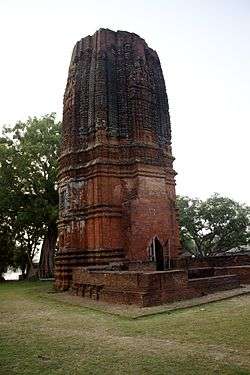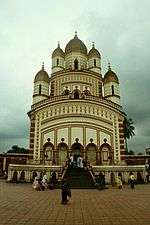Bahulara
| Bahulara | |
|---|---|
| Village | |
 Siddheshwara Temple at Bahulara | |
 Bahulara Location in West Bengal, India  Bahulara Bahulara (India) | |
| Coordinates: 23°10′10″N 87°14′20″E / 23.1694°N 87.2389°ECoordinates: 23°10′10″N 87°14′20″E / 23.1694°N 87.2389°E | |
| Country |
|
| State | West Bengal |
| District | Bankura |
| Population (2011) | |
| • Total | 1,124 |
| Languages | |
| • Official | Bengali, English |
| Time zone | UTC+5:30 (IST) |
| PIN | 722144 (Onda) |
| Telephone/STD code | 03244 |
| Lok Sabha constituency | Bishnupur |
| Vidhan Sabha constituency | Onda |
| Website |
bankura |
Bahulara (Bengali: বহুলাড়া) is a census village under Onda II village panchayat, in Onda CD Block in Bankura district in the Indian state of West Bengal. It is 5 km (3.1 mi) from Ondagram railway station and 25 km (16 mi) from Bishnupur.[1]
Siddheshwara temple
The Siddheshwara (সিদ্ধেশ্বর) Shiva temple at Bahulara is well known for its unique architectural style and exquisite cut-brick and lime-stucco ornamentation of the walls.[2] This shaivite temple, located upon a huge iron-age habitational or ritualistic mound, is considered to be the finest specimen of brick rekha deul temple made on the lines of Kalinga architecture and is ascribed to the early to mid-Pala period. Possibly it was built sometime approximately around 8th-11th century CE as a Jain/Buddhist shrine and later on got reconsecrated as a shaivite monument by the Malla monarchs of Bishnupur. Other than the central Shiva lingam the sanctum sanctorum or the garbhagriha has figurines of Ganesha, Jain tirthankar Parasanath and one of Mahisasurmardini. The exterior of the temple is covered with magnificent stucco ornamentation woven across beautiful intricacies of cut-brick designs. The area around the temple has many ancient relics and old mounds that echoes the extensive and intensive natures of long and enigmatic histories that the place entombs.[3] Height of this temple is 19.2 metre at present.
Situated on the banks of the Dwarakeswar River, "Siddheshwara temple at Bahulara in the Bankura district is probably the finest specimen of a brick built rekha deul temple of medieval period now standing in Bengal," according to Nalini Bhatta Sali. The topmost portion of the spire, called the amalaka, has been damaged at some point in the past, and furthermore in spite of recent restorative efforts by the government much of the temple's original ornamentations had fallen prey to the ravages of time. In the month of Chaitra the Bahulara Shiva Gajan takes place over the span of three days with hundreds of devotees attend the festival.[4]
Buddhist and Jain centre
The various habitational and ritualistic mounds surrounding the temple at Bahulara have led archeologists to speculate that it was a thriving Buddhist centre at some ancient point of time, with the added possibility of the presence of far older copper-bronze age proto-urban traces of pre-Aryan civilisation akin to the nearby sites of Dihar, Joykrishnapur, Birsinghapur, Gokulnagar, etc. The series of brick and stone-crafted mounds beside the deul are believed to be the ruins of Buddhist stupas where the remains of Buddhist bhikkhus and bhikkhunis were entombed after cremation. Prior to the dominance of Shaivism and Shaktism, the area was influenced successively by a myriad of pre-aryan chalcolithic socio-religious beliefs, Buddhism and Jainism from the late millenniums BCE to the early centuries CE until roughly the cusp of the 7th and 8th centuries CE when the kingdom of Mallabhum was established. A deep and pervasive spirit of intense socio-cultural and religious syncretism had always played a massive role in that general region (Rarh Bengal), and an early archaeological and architectural illustration of that syncretism can be glimpsed at through the curious presence of a Shivalinga-shaped Buddhist stupa beside the temple.[5]
Demographics
As per 2011 Census of India Bahulara had a total population of 1,124 of which 568 (51%) were males and 556 (49%) were females. Population below 6 years was 133. The total number of literates in Bahulara was 693 (69.93% of the population over 6 years).[6]
External links


References
- ↑ "Bahulara". India9.com. Retrieved 2008-03-17.
- ↑ "Incredible India". West Bengal. India tourism. Archived from the original on 2 March 2008. Retrieved 2008-03-17.
- ↑ "Bahulara". West Bengal. blessingsonthenet.com. Retrieved 2008-03-17.
- ↑ "Temples of West Bengal". Siddheswari temple. Hindu Links Universe. Retrieved 2008-03-17.
- ↑ Ghosh, Binoy, Paschim Banger Sanskriti, (in Bengali), part I, 1976 edition, p. 363, Prakash Bhaban
- ↑ "2011 Census – Primary Census Abstract Data Tables". West Bengal – District-wise. Registrar General and Census Commissioner, India. Retrieved 14 October 2016.
